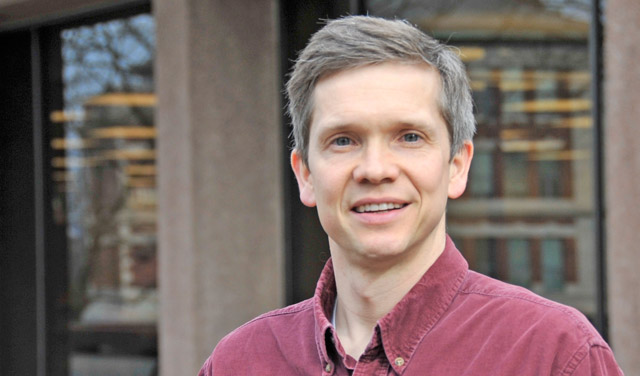5 Questions With…Greg Voth on Turbulence and Grain Flow

This issue, we ask “5 Questions” of Greg Voth, associate professor of physics.
Q: Professor Voth, what are your primary areas of research and how did you become involved in them?
A: My research group studies turbulent fluid flows and flows of granular materials. These complex systems have a wide range of environmental and industrial applications, but fundamental understanding of these systems has been held back because of the difficulty of measuring rapidly changing flow fields. Advances in high speed digital imaging over the past two decades have opened new ways to measure the trajectories of particles transported by these flows. I started studying turbulence during my graduate research in the mid 1990s, at Cornell Univ. There we built our own high speed imagers out of silicon strip detectors that had been designed for detecting sub-atomic particles in high-energy physics experiments. Since then, commercial high speed digital cameras have become available that are up to the task. At Wesleyan we have continued to develop innovative tools for video tracking of particles. One new tool we introduced is a system for real-time processing of the video data from high speed cameras.
Q: What is it about “turbulence” that merits this level of investigation?
A: Turbulence is one of the great unsolved problems of classical physics. Consider almost any fluid flow you wish. The Connecticut River is a good example. We know that the equations of fluid motion, called the Navier-Stokes equations, provide a very accurate model of the flow. But we cannot solve the equations for the flow in the river. The reason is that the equations are nonlinear and they have instabilities that lead to erratic swirling flow that we call turbulence. Although fluid flow in turbulence is unpredictable, many statistical properties of turbulent flows are found to be nearly universal, i.e. they are nearly the same for any turbulent fluid flow. So my research group performs laboratory experiments where we can make precise measurements of the statistics of particle motion in well controlled turbulent flows. The insights obtained can then be applied to any turbulent flow.
Q: What are some of the practical implications of your research?
A: Our measurements provide benchmarks that are used to improve the models which predict the effects of specific turbulent flows. One system that has received intense study recently is the dynamics of clouds. The uncertainties associated with cloud models are one of the largest uncertainties in predictions of the effects of increasing atmospheric CO2. Clouds are water droplets or ice crystals that are suspended in air, and the air is almost always turbulent. So understanding a cloud requires understanding particle motion in turbulence. Our measurements of acceleration statistics of particles in turbulence have been used to guide modeling of gravitational settling of cloud droplets which initiates rainfall.
Q: You recently joined a European research network on Particles in Turbulence. How did you become associated with this network?
A: The European Union office for Cooperation in Science and Technology (COST) recently funded a network of researchers who study particles in turbulence. The program provides funding for conferences, travel, and research collaborations. Since I was involved in the early experiments using high speed digital imaging to track particles in turbulence, I was asked to join the network as an ‘external member’, i.e. a participating member who is not from an EU country.
Q: What are the implications of this new association for your work and for Wesleyan students?
A: During the past two years, I have made three trips to Europe for conferences and a research collaboration during a sabbatical. COST paid for part of each of the trips. Last summer, Wesleyan undergraduate Nick Rotile worked with me on a collaboration to compare methods developed by different groups for stereoscopic tracking of particles. Currently, graduate student Shima Parsa is working with a collaboration we started at a recent COST conference to compare our experimental measurements of rod motion in turbulence with numerical simulations.

